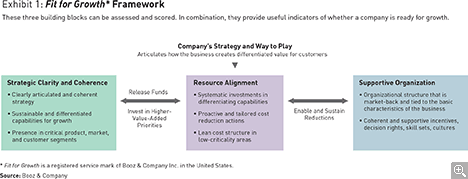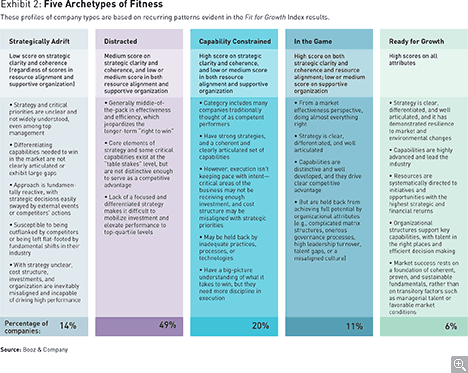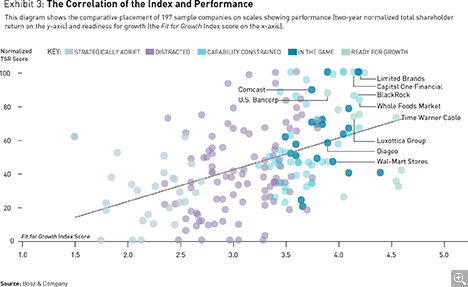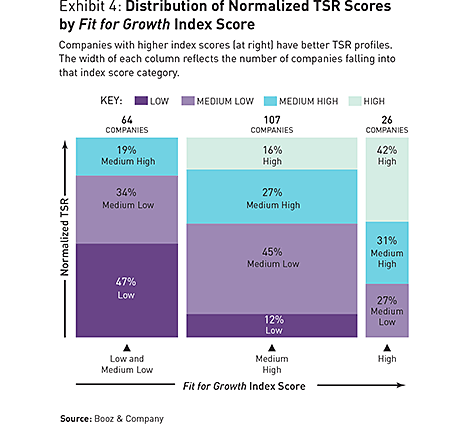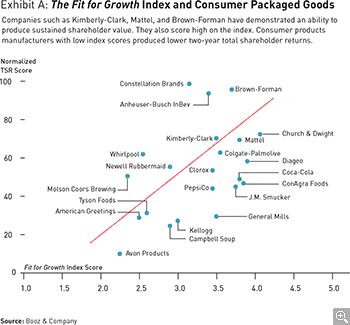How Ready Are You for Growth?
A Booz & Company study reveals that only 17 percent of companies are poised for a profitable future.
Note: This article was originally published by Booz & Company.
Since the economic crisis, many companies have been trying to figure out the best way to reposition themselves for greater performance and success in the future. Clearly the answer involves some combination of growth strategy and cost management. Over the past several years, working in a variety of industries, we have seen firsthand that companies that do three things together seem to be better positioned for a sustainable course of high performance. First, they create clarity and coherence in their strategy, articulating the differentiating capabilities that they will need to win in the marketplace. Second, they put in place an optimized cost structure and approach to capital allocation, with continual investment in the capabilities critical to success, while proactively cutting costs in less-critical areas to fund these investments. Third, they build supportive organizations. They redesign their structures, incentives, decision rights, skill sets, and other organizational and cultural elements to more closely align their behavior to their strategy, and to harness the collective actions of their people.
We call this the Fit for Growth* approach, because it builds competitive muscle while cutting the corporate fat that weighs a company down. At companies that use this approach, cost actions are creative and strategic (as opposed to reactive and tactical), freeing up funds to be reinvested in those parts of the business that are most important for growth (see Exhibit 1). At the same time, an organizational fabric is put in place that guides employees to do the right things day in and day out, helping the entire enterprise build and sustain competitive advantage (see “Is Your Company Fit for Growth?” by Deniz Caglar, Jaya Pandrangi, and John Plansky, s+b, Summer 2012).
To gauge the effectiveness of this approach, we created a quantitative metric—the Fit for Growth Index—that is built on its three core elements (see “Calculating the Fit for Growth Index” ). We then analyzed almost 200 companies headquartered in Europe and North America, selected from a wide range of industries. Most of these companies are active in markets around the world. We calculated an index score for each of these sample companies, based on an analysis of their basic business attributes (for example, their portfolio of products and presence in critical markets), and the key actions they had undertaken over a 24-month period to improve performance.
Calculating the Fit for Growth Index
The index assesses companies in three key areas: strategic clarity reinforced by an aligned group of capabilities; an aligned resource base and cost structure; and a supportive organization. Each company received a composite score from 1 to 5 based on its “fitness” in each of these areas (5 being the most fit). In calculating the scores, we weighted the three factors as follows: strategic clarity and coherence at 50 percent, resource alignment at 30 percent, and supportive organization at 20 percent. The second and third factors together constitute a company’s execution capability. Thus, a company’s index score is derived in equal parts from its strategy and its executional fitness. These weightings reflect our belief that strategy and execution are equally important in determining performance.
The three factors, in turn, were made up of several components, each with its own weighting. These subcomponents are:
- Strategic clarity and coherence: coherent strategy (15 percent), strong capabilities (10 percent), strong/coherent product portfolio (10 percent), presence in critical markets (15 percent)
- Resource alignment: systematic investments in differentiating capabilities (10 percent), thoughtful cost reduction (15 percent), and improvement initiatives aligned with strategy (5 percent)
- Supportive organization: speed and decisiveness (10 percent), strong leadership (5 percent), supportive culture (5 percent)
Our survey sample comprised 197 companies in 17 industries. Companies were chosen to yield a balanced sample including high, medium, and low financial performers in each industry, based on their total shareholder return over a two-year period. To supplement our knowledge of the companies, we examined information from research databases, analysts’ reports, earnings call transcripts, and business periodicals.
Finally, we compared the index values for each company with its total shareholder return (TSR) over the same period. By itself, the index provides a simple yet comprehensive check on a company’s readiness to grow. When combined with TSR data, it provides a framework for understanding which actions and attributes are likely to have the greatest impact on performance. We did, in fact, find a correlation: Companies with high scores on the Fit for Growth Index, as a group, scored higher in general performance as well.
A closer look at the index reveals that relatively few companies have comprehensively equipped themselves to drive superior growth. In fact, we found five recurring patterns in the scores: five types of companies, each with its own level of readiness for growth (see Exhibit 2). Like all archetypes, these are, of course, simplifications; their purpose is to distill the essential, common characteristics of each cluster, but not every company in an archetype group will display all the characteristics.
Nonetheless, all of the 197 companies we surveyed can be credibly assigned to one of the archetypes. When we did this, we found that more than three-quarters weren’t optimally equipped to win in their chosen space. A sizable majority were either “Distracted” (they lacked a clearly articulated “right to win” and set of differentiating capabilities) or “Capability Constrained” (they had not adequately operationalized a theoretically strong strategy and capabilities set). As might be expected, the number of companies that were “Strategically Adrift”—without a coherent strategy—was smaller; most major companies have developed a basic alignment to the needs of their market. The most telling finding: Only two categories, “In the Game” and “Ready for Growth,” provided consistently strong performance, and less than one-fifth of the companies (17 percent) fell into either of these two groups.
Performance and Readiness
What does this analysis tell us about corporate performance? How does a company’s “readiness for growth” affect its market return?
To measure the connection, we assigned each company a Fit for Growth Index score and compared it to the company’s total shareholder return over the two-year period from August 2010 through July 2012. Each company received a normalized TSR score between 0 and 100; 100 represented the company with the highest return in its industry segment, and 0 represented the company with the lowest. This form of calculation insulated the TSR results from external factors that might affect some sectors more than others—for example, higher-than-usual exposure to declines in spending due to the recession.
We found a strong correlation between shareholder return and levels of development in the key areas that make a company growth-ready. In addition, we discovered a clear “clumping” of archetypes. Those with similar patterns of development also had similar patterns of performance (see Exhibit 3).
Although the strength of the relationship varies by industry, our analysis confirms overall correlation. Almost three-quarters of companies with high index scores had high or medium-high TSR scores, and the companies with lower index scores tended to have lower TSR scores (see Exhibit 4).
Once the link between the index scores and market returns was established, the next logical question became, What specific elements, if any, in the index framework best explain strong performance? To find out, for each of 10 key subcomponents (listed in “Calculating the Fit for Growth Index”), we grouped our company sample into three bands (low, medium, and high scorers) and calculated the average TSR for each of those bands. This allowed us to determine those subcomponents that had the biggest gap between high- and low-scoring companies.
In general, we found distinct differences between the high and low TSR scorers. A few of the subcomponents within each of the building blocks (strategic clarity, resource alignment, and supportive organization) appear to have a particularly powerful impact on TSR scores. These are coherent strategy, strong capabilities, systematic investments, aligned initiatives, speed and decisiveness, and strong leadership. It should also be noted that even the high scorers in these areas achieved average TSR values of less than 60 on a scale from 0 to 100. This finding suggests that there is still room for improvement, even for this strongly performing peer group.
Implications for Management
Three messages emerge from our research. First is the clear relationship between the index scores and market performance. Doing well on the attributes of the index matters.
Second, the majority of companies we analyzed have some distance to go before they can be considered truly ready for sustainable growth. Only about a fifth of our sample fell under a strongly positive archetype (“In the Game” or “Ready for Growth”). To close this gap, the other companies would need to fine-tune their strategies, raise their differentiating capabilities to world-class levels, back up those capabilities with judicious cost restructuring and sustained and focused investment, and redesign their organization to be truly “fit for purpose.”
Third, the archetypes reveal specific factors that appear to matter more than others in explaining performance. In a world of tough choices, these constitute the logical places where companies should focus their attention first.
To chart a path forward, a company can calculate its own index score and determine the archetype that most closely matches its situation. Then, it can develop an action plan, focusing on the highest-return levers, to improve performance. For leaders of most companies—those that fall under the “Distracted” archetype—an action path could include:
- A rigorous review of the capabilities needed to achieve a leading position in their industry, versus those that are secondary
- A dispassionate assessment of where they stand against these capabilities on two fronts: their level of effectiveness, and their relative levels of funding and investment
- An action plan to scale back in the less-critical areas, and a corresponding plan to redirect funds from these areas to more critical needs
- A series of targeted organizational interventions to increase speed and quality of decision making throughout the enterprise
In the final analysis, most business leaders would agree that robust strategies, cost and investment management, and fine-tuned organizations are critical to performance. But they may not be aware of how much these factors can reinforce one another if the conditions are right. Mastering all three is the hard part; and our research shows that few companies do so. Making improvements requires a clear-headedness about one’s strengths and weaknesses, an understanding of the links to performance, and the development of a detailed plan of attack to reap the benefits. As is often the case, a good portion of the answer ultimately lies in focus and execution. ![]()
What a “Ready for Growth” Company Looks Like
Although every company is different, our analysis revealed a set of common characteristics that underpin many of the companies in the strongest “Ready for Growth” archetype. Consider these elements across the three building blocks of the framework.
•Strategic clarity and coherence: At “Ready for Growth” companies, strategic priorities are specific, actionable, and—most critically—widely understood at all levels of the company. Leaders make clear choices, striving for “best-in-class” prowess only in the distinctive capabilities that create sustainable competitive advantage, and accepting “good enough” in other areas. Through rigorous, forward-looking review processes, they are able to keep their strategies relevant, sensing and rapidly adapting to market changes. They’re quicker to innovate, are willing to make calculated big bets, and feel no qualms about killing investments that aren’t paying off.
• Resource alignment: In the area of resource allocation, “Ready for Growth” companies employ a disciplined process that ensures adequate funding for high-growth, core activities. Clear and objective investment criteria prevent department rivalries and other parochial concerns from interfering with the allocation of funds to top corporate priorities. These companies manage spending strategically, making rigorous trade-offs based on cost transparency and a deep understanding of how they earn money. Acquisitions are made only if they advance the company’s strategic positioning, and never if the target won’t be a good cultural fit.
• Supportive organization: “Ready for Growth” companies are organizationally efficient, flexible, and lean. They align their power structures and allocate decision rights in ways that best serve strategic priorities and business realities, rather than aligning them with historical legacies or individual agendas. They create nimble mechanisms for governance and collaboration across business units. Talent management practices support key capabilities by moving the best people into pivotal roles. A coherent culture sets norms and expectations that reflect the requirements for success in the marketplace. An ethos of excellence and continuous improvement prevails, reinforced by systems that reward performance.
Consumer Products and the Power of Fitness
by Deniz Caglar, Jaya Pandrangi, and Thomas Ripsam
To test the relationship between index scores and shareholder return, we looked closely at the consumer packaged goods industry. This industry is a good proving ground for several reasons: It’s a big industry with companies of all sizes that operate in markets around the world. Our sample comprised 23 companies in the food, beverage, household products, and related segments. Most are multinationals with a broad global presence.
These segments don’t exhibit identical results, but they do share certain broad characteristics relevant to our analysis of the factors that affect long-term performance. Their common foundational elements—such as a similar distribution channel structure—support basic comparability across companies. Perhaps most important, relatively low barriers to entry make consumer products a wide-open competitive battleground, where companies live or die by smart strategies and sharp execution. To win, consumer products companies must offer something customers really want but can’t get elsewhere. This requires a strategy that capitalizes on distinctive capabilities to create truly differentiated products. Companies can’t execute such a strategy unless they optimize costs and tailor their organization to deliver on the value proposition that sets them apart from competitors.
How, then, do index scores line up with shareholder return in the consumer products industry? We found a remarkably clear correlation (see Exhibit A).
The survey data also revealed which components of the index had the greatest impact on shareholder return. Gaps between high- and low-performing companies were greatest in factors related to strategic clarity and resource alignment. Differences between high- and medium-performing companies were most pronounced in the supportive organization category.
For deeper insight, we examined two particularly strong performers that embody the key principles of the Fit for Growth approach. Global beverage giant Diageo and Church & Dwight Company, a midsized company best known for its Arm & Hammer brand, stand out for the coherence of their strategies, the power of their differentiating capabilities, and their focused use of resources and organizational structures to create a right to win in the marketplace.
Diageo
Diageo is a global alcoholic beverages company with brands that include Johnnie Walker, Smirnoff, and Guinness. Diageo sells in more than 180 countries and derives 40 percent of its sales from emerging markets. These figures reflect the company’s overarching growth strategy of expanding leading brands into new markets, using a tailored approach for each.
Diageo relies on a small set of differentiating capabilities: marketing, supply chain and distribution channel efficiencies, innovation, and joint business planning with customers (known as the “Diageo Way of Selling”). Capabilities are adapted to meet the needs of local markets. For example, Diageo cultivates a premium image in North America, and emphasizes product innovation to middle-class consumers in emerging markets.
Diageo manages costs and investments to strengthen these key capabilities, in part by seeking efficiencies in other areas. It reduces costs through careful strategic sourcing of ingredients and other direct materials, operational optimization, alignment between its supply footprint and growth opportunities, and the use of value-enhancing distribution channels in emerging markets—to name a few of its tactics.
Diageo has built a fit-for-purpose, efficient, and effective organization. The company’s geographic organization maximizes brand value by combining a focus on individual growth markets with a global marketing support system. Employee satisfaction scores are high; many employees praise Diageo’s meritocratic culture, strong leadership, focus on results over “face time,” social responsibility, diversity, and work–life balance.
Church & Dwight
Church & Dwight has assembled a strong portfolio of home-care and personal-care brands in both the premium and value categories. Its strategy emphasizes identifying and acquiring niche brands with untapped residual equity, such as Nair and Pepsodent. Church & Dwight mines this value by giving the brands wide distribution and prominent shelf space, then cross-pollinates and extends the brands into adjacent categories.
This strategy requires superior capabilities in areas such as brand extension, innovation in categories in which a brand is the market leader, and being a “fast follower” in niches in which it is a value player. Church & Dwight develops these capabilities through resource alignment.
Investments focus on brand development and marketing for a small set of “power brands” that drive growth at the company. Innovation investments focus on breakthroughs in areas of market leadership, such as condoms (Trojan), and closely follow market leaders in value niches such as baking soda (Arm & Hammer). More broadly, Church & Dwight fosters a financial culture that is highly focused on performance, supported by aggressive cost management.
The approach has paid off for shareholders. Church & Dwight’s TSR has ranked among the highest returns of the consumer products industry for most of the past decade.
- Deniz Caglar is a partner with Booz & Company based in Chicago. He focuses on organizational design and cost fitness in the consumer packaged goods and retail industries.
- Jaya Pandrangi is a partner with Booz & Company in Cleveland. Her work focuses on growth and cost fitness strategy for consumer products and retail companies.
- Thomas Ripsam is a partner with Booz & Company based in Munich. He specializes in strategy-based improvement of top-line and bottom-line performance.
Reprint No. 00199
Author profiles:
- Ashok Divakaran is a partner with Booz & Company based in Chicago. He specializes in strategy-driven transformation for product- and innovation-based companies.
- Vinay Couto is a senior partner with Booz & Company based in Chicago. He is the global leader of the firm’s organization, change, and leadership practice, focusing on global organization restructuring and turnaround programs in the automotive, consumer packaged goods, and retail industries.
- Also contributing to this article were Booz & Company principal Jitendra Chhikara, senior associate Ritesh Sharma, and senior manager Marc Johnson.
- *Fit for Growth is a registered service mark of Booz & Company Inc. in the United States. (back to the top)



